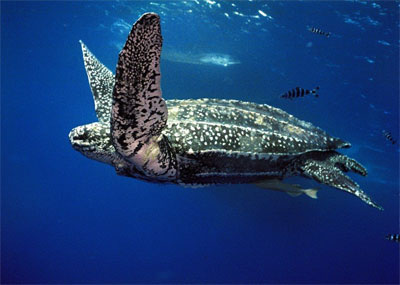 Interesting finding by Larry Crowder, one of the world’s leading sea turtle population biologists. His work was key in the imposition of Turtle Exclusion Devices into shrimp nets. The authors postulate that the increase was due in part to climate change (=more food) and overfishing of sharks (=fewer predators). With climate change there will be lots of winners and lots of losers. Leatherbacks are the largest of the seven sea turtle species and are listed as critically endangered. File under good news. – JB
Interesting finding by Larry Crowder, one of the world’s leading sea turtle population biologists. His work was key in the imposition of Turtle Exclusion Devices into shrimp nets. The authors postulate that the increase was due in part to climate change (=more food) and overfishing of sharks (=fewer predators). With climate change there will be lots of winners and lots of losers. Leatherbacks are the largest of the seven sea turtle species and are listed as critically endangered. File under good news. – JB
The number of endangered leatherback sea turtle nests at 68 beaches in Florida has increased by 10.2 percent a year since 1979, according to a new Duke University study.
Some beaches posted annual increases of more than 16 percent, others as low as 3.1 percent. The population boom of turtle nests in the Sunshine State mirrors trends observed for other Atlantic leatherback sea turtle populations and is “very encouraging news,” says Larry B. Crowder, director of the Duke Center for Marine Conservation. “It suggests that conservation and recovery efforts mandated under the Endangered Species Act are paying off region-wide.”
The growth has likely been fueled in part by improved monitoring and protection of nesting beaches over the last 30 years, Crowder says, but other less benign factors may also be at work. “Nesting is increasing even where beach protection has not been enhanced,” he says. “Changing ocean conditions linked to climate variability may be altering the marine food web and creating an environment that favors turtles by reducing the number of predators and increasing the abundance of prey, particularly jellyfish.”
With plenty of jellyfish to munch on, breeding-age female leatherbacks may be able to build up fat reserves more quickly, allowing them to nest more frequently, says Kelly Stewart, lead author of the study. Stewart received her Ph.D. from Duke in 2007 and conducted the research on Florida’s leatherback sea turtles as her dissertation research. Crowder was her faculty adviser.
Reduced populations of large predators, including the collapse of shark populations in the northwest Atlantic over the past decade, may be playing an even larger role in the turtle boom by decreasing at-sea mortality rates for juvenile and young adult turtles, she says.
Read it all here at ScienceDaily
Leave a Reply